Haiyang Xu
VideoNSA: Native Sparse Attention Scales Video Understanding
Oct 02, 2025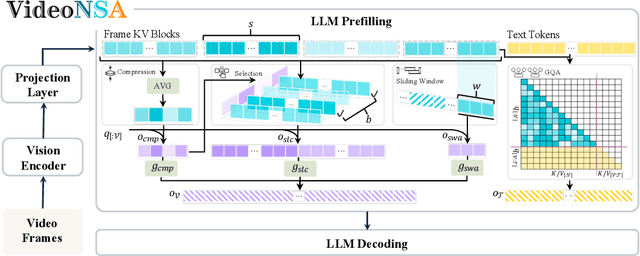
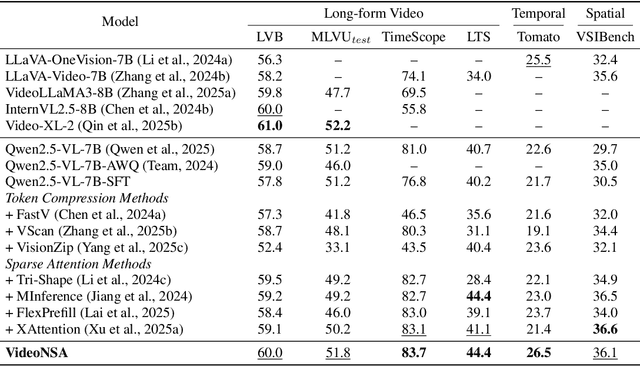
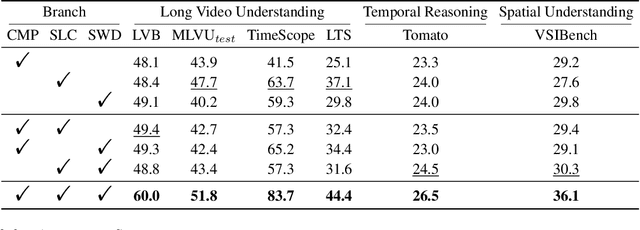
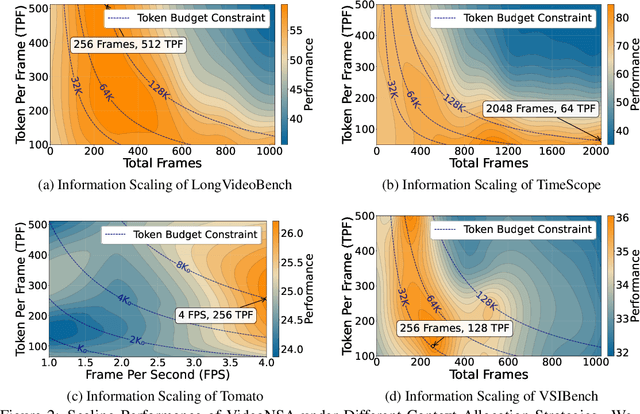
Abstract:Video understanding in multimodal language models remains limited by context length: models often miss key transition frames and struggle to maintain coherence across long time scales. To address this, we adapt Native Sparse Attention (NSA) to video-language models. Our method, VideoNSA, adapts Qwen2.5-VL through end-to-end training on a 216K video instruction dataset. We employ a hardware-aware hybrid approach to attention, preserving dense attention for text, while employing NSA for video. Compared to token-compression and training-free sparse baselines, VideoNSA achieves improved performance on long-video understanding, temporal reasoning, and spatial benchmarks. Further ablation analysis reveals four key findings: (1) reliable scaling to 128K tokens; (2) an optimal global-local attention allocation at a fixed budget; (3) task-dependent branch usage patterns; and (4) the learnable combined sparse attention help induce dynamic attention sinks.
Mobile-Agent-v3: Foundamental Agents for GUI Automation
Aug 21, 2025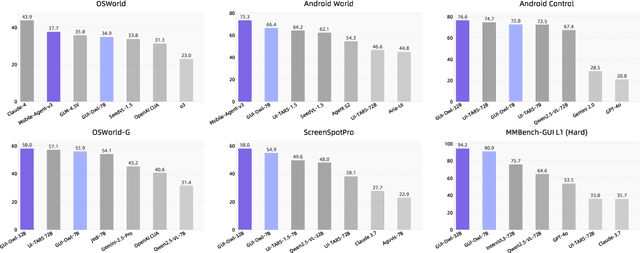
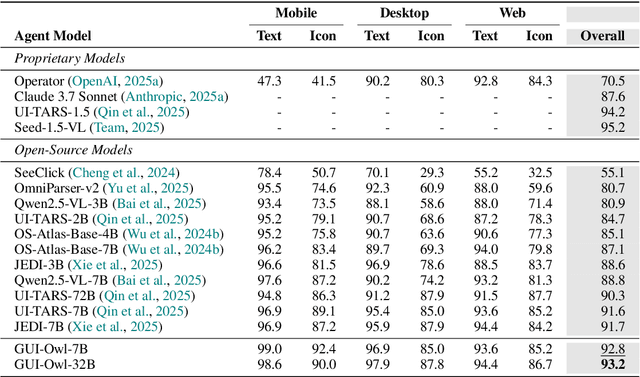
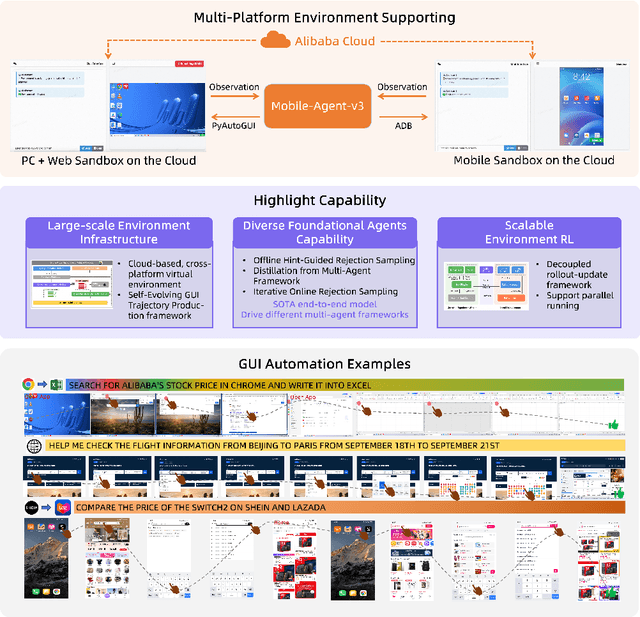
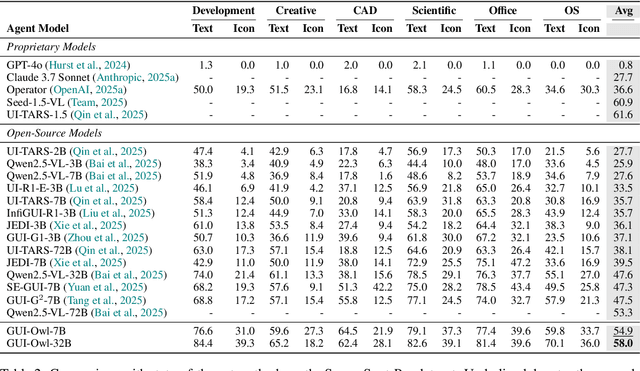
Abstract:This paper introduces GUI-Owl, a foundational GUI agent model that achieves state-of-the-art performance among open-source end-to-end models on ten GUI benchmarks across desktop and mobile environments, covering grounding, question answering, planning, decision-making, and procedural knowledge. GUI-Owl-7B achieves 66.4 on AndroidWorld and 29.4 on OSWorld. Building on this, we propose Mobile-Agent-v3, a general-purpose GUI agent framework that further improves performance to 73.3 on AndroidWorld and 37.7 on OSWorld, setting a new state-of-the-art for open-source GUI agent frameworks. GUI-Owl incorporates three key innovations: (1) Large-scale Environment Infrastructure: a cloud-based virtual environment spanning Android, Ubuntu, macOS, and Windows, enabling our Self-Evolving GUI Trajectory Production framework. This generates high-quality interaction data via automated query generation and correctness validation, leveraging GUI-Owl to refine trajectories iteratively, forming a self-improving loop. It supports diverse data pipelines and reduces manual annotation. (2) Diverse Foundational Agent Capabilities: by integrating UI grounding, planning, action semantics, and reasoning patterns, GUI-Owl supports end-to-end decision-making and can act as a modular component in multi-agent systems. (3) Scalable Environment RL: we develop a scalable reinforcement learning framework with fully asynchronous training for real-world alignment. We also introduce Trajectory-aware Relative Policy Optimization (TRPO) for online RL, achieving 34.9 on OSWorld. GUI-Owl and Mobile-Agent-v3 are open-sourced at https://github.com/X-PLUG/MobileAgent.
YOLO-Count: Differentiable Object Counting for Text-to-Image Generation
Aug 01, 2025Abstract:We propose YOLO-Count, a differentiable open-vocabulary object counting model that tackles both general counting challenges and enables precise quantity control for text-to-image (T2I) generation. A core contribution is the 'cardinality' map, a novel regression target that accounts for variations in object size and spatial distribution. Leveraging representation alignment and a hybrid strong-weak supervision scheme, YOLO-Count bridges the gap between open-vocabulary counting and T2I generation control. Its fully differentiable architecture facilitates gradient-based optimization, enabling accurate object count estimation and fine-grained guidance for generative models. Extensive experiments demonstrate that YOLO-Count achieves state-of-the-art counting accuracy while providing robust and effective quantity control for T2I systems.
DepR: Depth Guided Single-view Scene Reconstruction with Instance-level Diffusion
Jul 30, 2025Abstract:We propose DepR, a depth-guided single-view scene reconstruction framework that integrates instance-level diffusion within a compositional paradigm. Instead of reconstructing the entire scene holistically, DepR generates individual objects and subsequently composes them into a coherent 3D layout. Unlike previous methods that use depth solely for object layout estimation during inference and therefore fail to fully exploit its rich geometric information, DepR leverages depth throughout both training and inference. Specifically, we introduce depth-guided conditioning to effectively encode shape priors into diffusion models. During inference, depth further guides DDIM sampling and layout optimization, enhancing alignment between the reconstruction and the input image. Despite being trained on limited synthetic data, DepR achieves state-of-the-art performance and demonstrates strong generalization in single-view scene reconstruction, as shown through evaluations on both synthetic and real-world datasets.
Megrez2 Technical Report
Jul 23, 2025Abstract:We present Megrez2, a novel lightweight and high-performance language model architecture optimized for device native deployment. Megrez2 introduces a novel cross-layer expert sharing mechanism, which significantly reduces total parameter count by reusing expert modules across adjacent transformer layers while maintaining most of the model's capacity. It also incorporates pre-gated routing, enabling memory-efficient expert loading and faster inference. As the first instantiation of the Megrez2 architecture, we introduce the Megrez2-Preview model, which is pre-trained on a 5-trillion-token corpus and further enhanced through supervised fine-tuning and reinforcement learning with verifiable rewards. With only 3B activated and 7.5B stored parameters, Megrez2-Preview demonstrates competitive or superior performance compared to larger models on a wide range of tasks, including language understanding, instruction following, mathematical reasoning, and code generation. These results highlight the effectiveness of the Megrez2 architecture to achieve a balance between accuracy, efficiency, and deployability, making it a strong candidate for real-world, resource-constrained applications.
Perception-Aware Policy Optimization for Multimodal Reasoning
Jul 08, 2025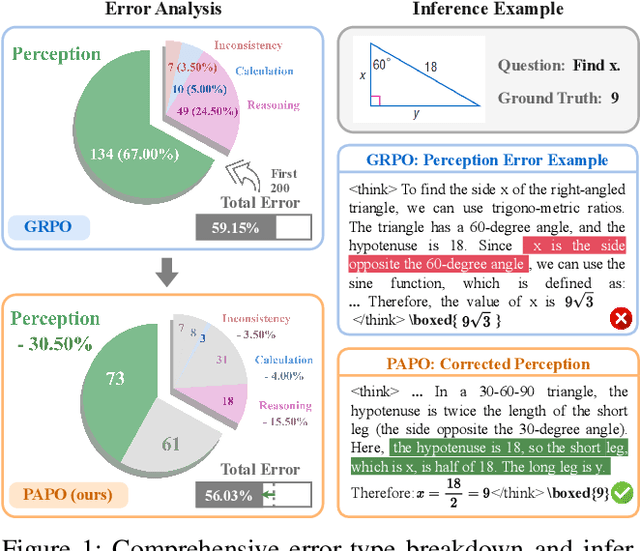

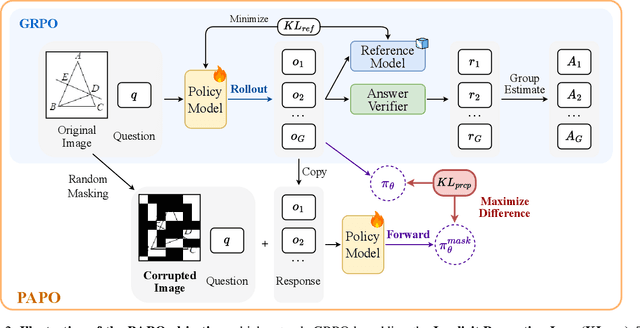

Abstract:Reinforcement Learning with Verifiable Rewards (RLVR) has proven to be a highly effective strategy for endowing Large Language Models (LLMs) with robust multi-step reasoning abilities. However, its design and optimizations remain tailored to purely textual domains, resulting in suboptimal performance when applied to multimodal reasoning tasks. In particular, we observe that a major source of error in current multimodal reasoning lies in the perception of visual inputs. To address this bottleneck, we propose Perception-Aware Policy Optimization (PAPO), a simple yet effective extension of GRPO that encourages the model to learn to perceive while learning to reason, entirely from internal supervision signals. Notably, PAPO does not rely on additional data curation, external reward models, or proprietary models. Specifically, we introduce the Implicit Perception Loss in the form of a KL divergence term to the GRPO objective, which, despite its simplicity, yields significant overall improvements (4.4%) on diverse multimodal benchmarks. The improvements are more pronounced, approaching 8.0%, on tasks with high vision dependency. We also observe a substantial reduction (30.5%) in perception errors, indicating improved perceptual capabilities with PAPO. We conduct comprehensive analysis of PAPO and identify a unique loss hacking issue, which we rigorously analyze and mitigate through a Double Entropy Loss. Overall, our work introduces a deeper integration of perception-aware supervision into RLVR learning objectives and lays the groundwork for a new RL framework that encourages visually grounded reasoning. Project page: https://mikewangwzhl.github.io/PAPO.
Look Before You Leap: A GUI-Critic-R1 Model for Pre-Operative Error Diagnosis in GUI Automation
Jun 05, 2025Abstract:In recent years, Multimodal Large Language Models (MLLMs) have been extensively utilized for multimodal reasoning tasks, including Graphical User Interface (GUI) automation. Unlike general offline multimodal tasks, GUI automation is executed in online interactive environments, necessitating step-by-step decision-making based on real-time status of the environment. This task has a lower tolerance for decision-making errors at each step, as any mistakes may cumulatively disrupt the process and potentially lead to irreversible outcomes like deletions or payments. To address these issues, we introduce a pre-operative critic mechanism that provides effective feedback prior to the actual execution, by reasoning about the potential outcome and correctness of actions. Specifically, we propose a Suggestion-aware Gradient Relative Policy Optimization (S-GRPO) strategy to construct our pre-operative critic model GUI-Critic-R1, incorporating a novel suggestion reward to enhance the reliability of the model's feedback. Furthermore, we develop a reasoning-bootstrapping based data collection pipeline to create a GUI-Critic-Train and a GUI-Critic-Test, filling existing gaps in GUI critic data. Static experiments on the GUI-Critic-Test across both mobile and web domains reveal that our GUI-Critic-R1 offers significant advantages in critic accuracy compared to current MLLMs. Dynamic evaluation on GUI automation benchmark further highlights the effectiveness and superiority of our model, as evidenced by improved success rates and operational efficiency.
VLM-R$^3$: Region Recognition, Reasoning, and Refinement for Enhanced Multimodal Chain-of-Thought
May 22, 2025Abstract:Recently, reasoning-based MLLMs have achieved a degree of success in generating long-form textual reasoning chains. However, they still struggle with complex tasks that necessitate dynamic and iterative focusing on and revisiting of visual regions to achieve precise grounding of textual reasoning in visual evidence. We introduce \textbf{VLM-R$^3$} (\textbf{V}isual \textbf{L}anguage \textbf{M}odel with \textbf{R}egion \textbf{R}ecognition and \textbf{R}easoning), a framework that equips an MLLM with the ability to (i) decide \emph{when} additional visual evidence is needed, (ii) determine \emph{where} to ground within the image, and (iii) seamlessly weave the relevant sub-image content back into an interleaved chain-of-thought. The core of our method is \textbf{Region-Conditioned Reinforcement Policy Optimization (R-GRPO)}, a training paradigm that rewards the model for selecting informative regions, formulating appropriate transformations (e.g.\ crop, zoom), and integrating the resulting visual context into subsequent reasoning steps. To bootstrap this policy, we compile a modest but carefully curated Visuo-Lingual Interleaved Rationale (VLIR) corpus that provides step-level supervision on region selection and textual justification. Extensive experiments on MathVista, ScienceQA, and other benchmarks show that VLM-R$^3$ sets a new state of the art in zero-shot and few-shot settings, with the largest gains appearing on questions demanding subtle spatial reasoning or fine-grained visual cue extraction.
Mobile-Agent-V: A Video-Guided Approach for Effortless and Efficient Operational Knowledge Injection in Mobile Automation
May 21, 2025Abstract:The exponential rise in mobile device usage necessitates streamlined automation for effective task management, yet many AI frameworks fall short due to inadequate operational expertise. While manually written knowledge can bridge this gap, it is often burdensome and inefficient. We introduce Mobile-Agent-V, an innovative framework that utilizes video as a guiding tool to effortlessly and efficiently inject operational knowledge into mobile automation processes. By deriving knowledge directly from video content, Mobile-Agent-V eliminates manual intervention, significantly reducing the effort and time required for knowledge acquisition. To rigorously evaluate this approach, we propose Mobile-Knowledge, a benchmark tailored to assess the impact of external knowledge on mobile agent performance. Our experimental findings demonstrate that Mobile-Agent-V enhances performance by 36% compared to existing methods, underscoring its effortless and efficient advantages in mobile automation.
Cost-Effective, Low Latency Vector Search with Azure Cosmos DB
May 09, 2025Abstract:Vector indexing enables semantic search over diverse corpora and has become an important interface to databases for both users and AI agents. Efficient vector search requires deep optimizations in database systems. This has motivated a new class of specialized vector databases that optimize for vector search quality and cost. Instead, we argue that a scalable, high-performance, and cost-efficient vector search system can be built inside a cloud-native operational database like Azure Cosmos DB while leveraging the benefits of a distributed database such as high availability, durability, and scale. We do this by deeply integrating DiskANN, a state-of-the-art vector indexing library, inside Azure Cosmos DB NoSQL. This system uses a single vector index per partition stored in existing index trees, and kept in sync with underlying data. It supports < 20ms query latency over an index spanning 10 million of vectors, has stable recall over updates, and offers nearly 15x and 41x lower query cost compared to Zilliz and Pinecone serverless enterprise products. It also scales out to billions of vectors via automatic partitioning. This convergent design presents a point in favor of integrating vector indices into operational databases in the context of recent debates on specialized vector databases, and offers a template for vector indexing in other databases.
 Add to Chrome
Add to Chrome Add to Firefox
Add to Firefox Add to Edge
Add to Edge